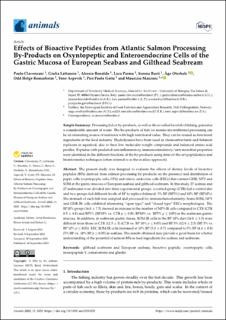Effects of Bioactive Peptides from Atlantic Salmon Processing By-Products on Oxyntopeptic and Enteroendocrine Cells of the Gastric Mucosa of European Seabass and Gilthead Seabream
Clavenzani, Paolo; Lattanzio, Giulia; Bonaldo, Alessio; Parma, Luca; Busti, Serena; Oterhals, Åge; Romarheim, Odd Helge; Aspevik, Tone; Gatta, Pier Paolo; Mazzoni, Maurizio
Peer reviewed, Journal article
Published version
Permanent lenke
https://hdl.handle.net/11250/3101543Utgivelsesdato
2023Metadata
Vis full innførselSamlinger
- Artikler / Articles [1427]
- Publikasjoner fra CRIStin [2490]
Sammendrag
The present study was designed to evaluate the effects of dietary levels of bioactive peptides (BPs) derived from salmon processing by-products on the presence and distribution of peptic cells (oxyntopeptic cells, OPs) and enteric endocrine cells (EECs) that contain GHR, NPY and SOM in the gastric mucosa of European seabass and gilthead seabream. In this study, 27 seabass and 27 seabreams were divided into three experimental groups: a control group (CTR) fed a control diet and two groups fed different levels of BP to replace fishmeal: 5% BP (BP5%) and 10% BP (BP10%). The stomach of each fish was sampled and processed for immunohistochemistry. Some SOM, NPY and GHR-IR cells exhibited alternating “open type” and “closed type” EECs morphologies. The BP10% group (16.8 ± 7.5) showed an increase in the number of NPY-IR cells compared to CTR (CTR 8.5 ± 4.8) and BP5% (BP10% vs. CTR p ≤ 0.01; BP10% vs. BP5% p ≤ 0.05) in the seabream gastric mucosa. In addition, in seabream gastric tissue, SOM-IR cells in the BP 10% diet (16.8 ± 3.5) were different from those in CTR (12.5 ± 5) (CTR vs. BP 10% p ≤ 0.05) and BP 5% (12.9 ± 2.5) (BP 5% vs. BP 10% p ≤ 0.01). EEC SOM-IR cells increased at 10% BP (5.3 ± 0.7) compared to 5% BP (4.4 ± 0.8) (5% BP vs. 10% BP p ≤ 0.05) in seabass. The results obtained may provide a good basis for a better understanding of the potential of salmon BPs as feed ingredients for seabass and seabream.
